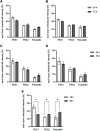Development of a Mass Spectrometry Imaging Method to Evaluate the Penetration of Moisturizing Components Coated on Surgical Gloves into Artificial Membranes
- PMID: 38577169
- PMCID: PMC10990723
- DOI: 10.5702/massspectrometry.A0145
Development of a Mass Spectrometry Imaging Method to Evaluate the Penetration of Moisturizing Components Coated on Surgical Gloves into Artificial Membranes
Erratum in
-
Erratum: Development of a Mass Spectrometry Imaging Method to Evaluate the Penetration of Moisturizing Components Coated on Surgical Gloves into Artificial Membranes.Mass Spectrom (Tokyo). 2025;14(1):X0003. doi: 10.5702/massspectrometry.X0003. Epub 2025 Mar 27. Mass Spectrom (Tokyo). 2025. PMID: 40151197 Free PMC article.
Abstract
Skin dryness and irritant contact dermatitis induced by the prolonged use of surgical gloves are issues faced by physicians. To address these concerns, manufacturers have introduced surgical gloves that incorporate a moisturizing component on their inner surface, resulting in documented results showing a reduction in hand dermatitis. However, the spatial distribution of moisturizers applied to surgical gloves within the integument remains unclear. Using matrix-assisted laser desorption/ionization (MALDI)-mass spectrometry imaging (MSI), we investigated the spatial distribution of moisturizers in surgical gloves within artificial membranes. Recently, dermal permeation assessments using three-dimensional models, silicone membranes, and Strat-M have gained attention as alternative approaches to animal testing. Therefore, in this study, we established an in vitro dermal permeation assessment of commercially available moisturizers in surgical gloves using artificial membranes. In this study, we offer a methodology to visualize the infiltration of moisturizers applied to surgical gloves into an artificial membrane using MALDI-MSI, while evaluating commercially available moisturizer-coated surgical gloves. Using our penetration evaluation method, we confirmed the infiltration of the moisturizers into the polyethersulfone 2 and polyolefin layers, which correspond to the epidermis and dermis of the skin, after the use of surgical gloves. The MSI-based method presented herein demonstrated the efficacy of evaluating the permeation of samples containing active ingredients.
Keywords: animal substitutes; artificial membranes; mass spectrometry imaging; moisturizing coating compounds; surgical gloves.
Copyright © 2024 Erika Nagano, Kazuki Odake, Toru Akiyoshi, and Shuichi Shimma.
Figures






Similar articles
-
Erratum: Development of a Mass Spectrometry Imaging Method to Evaluate the Penetration of Moisturizing Components Coated on Surgical Gloves into Artificial Membranes.Mass Spectrom (Tokyo). 2025;14(1):X0003. doi: 10.5702/massspectrometry.X0003. Epub 2025 Mar 27. Mass Spectrom (Tokyo). 2025. PMID: 40151197 Free PMC article.
-
Evaluation of Disposable Protective Garments against Isocyanate Permeation and Penetration from Polyurethane Anticorrosion Coatings.Ann Work Expo Health. 2019 May 21;63(5):592-603. doi: 10.1093/annweh/wxz032. Ann Work Expo Health. 2019. PMID: 31066890
-
Evaluation of dermal extracellular matrix and epidermal-dermal junction modifications using matrix-assisted laser desorption/ionization mass spectrometric imaging, in vivo reflectance confocal microscopy, echography, and histology: effect of age and peptide applications.J Cosmet Dermatol. 2015 Jun;14(2):152-60. doi: 10.1111/jocd.12135. Epub 2015 Mar 27. J Cosmet Dermatol. 2015. PMID: 25817264
-
Role of topical emollients and moisturizers in the treatment of dry skin barrier disorders.Am J Clin Dermatol. 2003;4(11):771-88. doi: 10.2165/00128071-200304110-00005. Am J Clin Dermatol. 2003. PMID: 14572299 Review.
-
Visualization of Functional Food Factors by Matrix-Assisted Laser Desorption/Ionization Imaging Mass Spectrometry.J Nutr Sci Vitaminol (Tokyo). 2022;68(Supplement):S143-S145. doi: 10.3177/jnsv.68.S143. J Nutr Sci Vitaminol (Tokyo). 2022. PMID: 36437000 Review.
References
-
- S. Skotnicki. The Workplace Safety and Insurance Appeals Tribunal, 2008. (https://www.wsiat.on.ca/en/MedicalDiscussionPapers/allergic.pdf).
-
- E. Proksch, J. M. Brandner, J. M. Jensen. The skin: An indispensable barrier. Exp. Dermatol. 17: 1063–1072, 2008. - PubMed
-
- A. V. Rawlings. Recent advances in skin ‘barrier’ research. J. Pharm. Pharmacol. 62: 671–677, 2010. - PubMed
-
- E. L. Larson, C. A. Norton Hughes, J. D. Pyrek, S. M. Sparks, E. U. Cagatay, J. M. Bartkus. Changes in bacterial flora associated with skin damage on hands of health care personnel. Am. J. Infect. Control 26: 513–521, 1998. - PubMed

